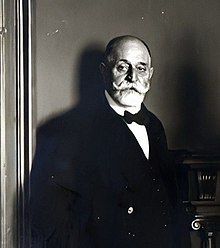Đorđe Vajfert
| Đorđe Vajfert Ђорђе Вајферт |
|
|---|---|
 |
|
| 3rd Governor of the National Bank of Serbia | |
|
In office 1890–1902 |
|
| Preceded by | Filip Hristić |
| Succeeded by | Tihomilj J. Marković |
| 5th Governor of the National Bank of Serbia (Yugoslavia) | |
|
In office 1912–1926 |
|
| Preceded by | Tihomilj J. Marković |
| Succeeded by | Ljubomir Srećković |
| Personal details | |
| Born | 15 June 1850 Pančevo, Austrian Empire |
| Died | 12 January 1937 Belgrade, Kingdom of Yugoslavia |
| Nationality | Serbian |
| Signature | |
Đorđe Vajfert (Serbian Cyrillic: Ђорђе Вајферт, German: Georg Weifert; 15 June 1850 – 12 January 1937) was a Serbian industrialist of German descent, Governor of the National Bank of Serbia and later Yugoslavia. In addition, he is considered the founder of the modern mining sector in Serbia and a great benefactor.
Georg Weifert was born in Pančevo, German Banat to a Danube Swabian family. From an early age Đorđe Vajfert worked with his father, Ignatz Weifert in Belgrade, in brewing. Theirs was the first brewery in the Kingdom of Serbia. He graduated from the Braumeisterschule in Weihenstephan, near Munich. Then he returned to Serbia and took over the brewery of his father, which he expanded. With the profits he bought a coal mine in Kostolac, then a copper mine in Bor, a Steinberg works at Zaječar and finally a gold mine. With the proceeds from the mines, he was the richest man in Serbia and was considered the greatest industrialist of the future Yugoslavia.
In 1890 Vajfert was appointed Governor of the National Bank of Serbia. He served in this capacity from 1890 to 1902, and again from 1912 to 1914/1918. During this period he acquired a good reputation maintaining the value of the Serbian dinar and in credit. After 1918, because of his good offices, Vajfert was appointed Governor of the National Bank of Yugoslavia. His best-known arrangement as Governor was the conversion of the Austro-Hungarian krone into the new Yugoslav dinar. This also led to great criticism, as the former Serbian dinar was exchanged 1:1 in the new dinar, the Austrian money into a 4:1 ratio - this led to substantial losses of property of those Yugoslavs who formerly lived in Austria-Hungary.
...
Wikipedia
